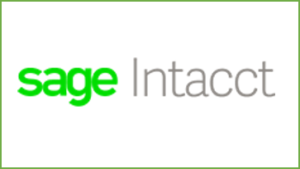
Preface: Tim Rodman and I have previously engaged in good-natured debates about Acumatica and Sage. In Tim’s latest blog, he speculates about the effect of Sage’s acquisition of Intacct. Here’s my take.
Last week, Sage announced the acquisition of Intacct, a well-established SaaS solution targeting Small to Medium sized enterprise organizations. Intacct has a solid customer base of more than 11,000 clients and a devoted reseller ecosystem.
Will Intacct become stagnant?
Tim makes some valid points about acquisitions and technology becoming stagnant. However, Sage 500 was one of the few solutions that was internally developed by what is now Sage North America. Yes, it’s on older technology and has a likely end-of-life, whenever that is, but that seems irrelevant in this conversation. Separate products, legacies and market approaches.
It’s too early to speculate on what Sage’s long-term objectives may be with Sage Intacct, but it is also very poignant that Sage was behind the curve with its Cloud Business portfolio. It’s reasonable to point out that this accelerates Sage Business Cloud growth in the midmarket with a proven Cloud solution, 11,000 customers and brand awareness.
This acquisition clearly solidifies the Sage Business Cloud suite strategy, too. Portfolio strategy is what differentiates Sage from its competitors. From startup through scale-up to enterprise, Sage has a solution for customers during that transformation journey. Consider the following as proof:
- Sage Live. Built on the Saleforce.com platform and focused on startup organizations to compete with QuickBooks.
- Sage X3 Cloud. True web-based application architected with a multitenant application layer and single-tenant database, it targets upper midmarket enterprise with more complex business processes and organizational requirements.
- Sage Intacct. Intacct will slide nicely in between these solutions for companies that have outgrown Sage Live - or other Sage products - but aren’t quite ready for Sage X3.
Intacct is Industry Focused
Publishers generally have two options with go-to-market strategies: best of breed or industry focused. To this point, Intacct has done an exceptional job on focusing what it does best, delivering Accounting solutions for Healthcare, Hospitality, Nonprofits and Service organizations. It has grown by focusing on these industries without the disruption of maintaining add-on solutions for distributor and manufacturers. Again, it’s purely speculative to predict how this acquisition effects the Intacct product roadmap, but it has not previously been positioned as a best of breed offering.
This acquisition does not overlap the current product portfolio for Sage and allows partners like us to enter new markets and attract new clients. Sage Intacct is complementary to the existing Sage Business Cloud and on-premises hybrid products - filling out the portfolio to support any prospect or customer needs.
Connectivity is not an issue with Intacct
Without getting too technical, Sage Intacct uses Web Services gateways to interact between on-premise and/or cloud applications. Using Web Services, Sage Intacct leverages cloud storage and business logic via published schemas, SDKs (Software Development Toolkit) and the underlying XML API framework. In summary, it’s easy to connect Intacct to external applications using its toolset and open source library applications. If anything, the acquisition by Sage could possibly introduce more connected-solution opportunities, leveraging Sage’s portfolio of complementary solutions like HCM (Human Capital Management), Fixed Assets and other marketplace solutions.
Publisher Viability, Portfolio and Brand
The acquisition of Intacct reinforces Sage’s position as the third largest ERP software publisher in the world. With a diverse international portfolio, more than 6M customers worldwide, and industry solutions for start-ups to enterprises, Sage has a portfolio that competitors envy. You can argue that some products lack technology upgrades, but the primary objective of this acquisition is the Sage Cloud Business strategy.
Tim also suggests potential confusion among existing Sage solutions and customers. With its current portfolio of Sage 100c, Sage 300, Sage X3, and more- technology notwithstanding – Sage on-premise solutions mainly focus on distributors and manufacturers. With the addition of Intacct, Sage now has a Cloud solution offering for Healthcare, Hospitality, Nonprofits and Service organizations. Rather than overlapping its current portfolio, Sage Intacct presents an opportunity for Sage to enter new markets and attract new clients.
How will Sage Partners respond?
I can’t speak for every partner but, partners that I know and have talked to are excited about the possibilities that this acquisition creates. Sage has always been a ‘Partner-centric’ organization with a mature partner channel ecosystem. How we as partners recognize software sales revenue is important but it’s not the driving force behind our businesses initiatives. What is important is having a publisher that delivers a quality product coupled with our expertise to deliver professional services for an on-time, on-budget and successful project engagement.
Opportunities with Sage Intacct
From my perspective, this is an exciting time to be a customer and partner with Sage. As RKL eSolutions evaluates the benefits of this acquisition, we believe it is additive and complementary to the existing Sage portfolio, not a replacement of current solutions. We are anxious to learn more about the Intacct solution and how we can go-to-market to attract new clients, offer current clients better migration opportunities to the Cloud and entertain new industries.
Got Questions?
Contact us if you have questions regarding the Sage Intacct acquisition.
Contact RKL eSolutions


